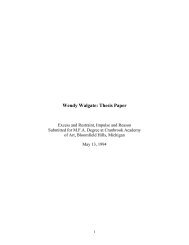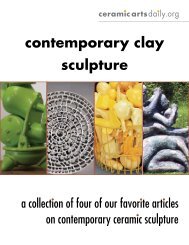Narrative Cycles on the Hagia Triada Sarcophagus - Wendy Walgate
Narrative Cycles on the Hagia Triada Sarcophagus - Wendy Walgate
Narrative Cycles on the Hagia Triada Sarcophagus - Wendy Walgate
- No tags were found...
You also want an ePaper? Increase the reach of your titles
YUMPU automatically turns print PDFs into web optimized ePapers that Google loves.
similar to <strong>the</strong> Minoan artist’s apparent appreciati<strong>on</strong> of natural phenomena. He uses <strong>the</strong>undulating line in many of his outdoor sculptures and whenever this design appears, inside aRoman sarcophagus or traced through a bed of sand, <strong>the</strong> artist is signifying <strong>the</strong> c<strong>on</strong>tinuousbehavior of nature and man (Fig. 10). Goldsworthy states, “It is not a river . . . but in calling it<strong>on</strong>e I hope to touch <strong>on</strong> <strong>the</strong> movement associated with a river. A river for me is not bound towater. It is <strong>the</strong> flow, not <strong>the</strong> water that is important – a river of wind, animals, birds, insects,people, seas<strong>on</strong>s, climate, st<strong>on</strong>e, earth, colour . . .” 48Marinatos points out that although “Cretedoes not have many rivers . . . <strong>the</strong> whole ic<strong>on</strong>ographical package, river plus plants and animalswas inspired by Egyptian or Near Eastern prototypes . . . for in <strong>the</strong> ic<strong>on</strong>ographical code of <strong>the</strong>great river civilizati<strong>on</strong>s, rivers equal fertility.” 49Wavy lines radiate al<strong>on</strong>g <strong>the</strong> borders of both chariots scenes of <strong>the</strong> two ends of <strong>the</strong> HTS.Although this pattern is usually interpreted as a “variegated rock pattern,” 50 it could alsoreference <strong>the</strong> passage of <strong>the</strong> deceased by chariot over <strong>the</strong> water to <strong>the</strong> afterworld.Directi<strong>on</strong>al Progressi<strong>on</strong> in Spiral – Chart 4L<strong>on</strong>g states that <strong>the</strong> running spiral border and rosette pattern were used extensively atKnossos in <strong>the</strong> Neoplatial period. 51The S-spirals <strong>on</strong> <strong>the</strong> HTS, in which blue and white paintsaccentuate an “S” in <strong>the</strong> design, occur <strong>on</strong> a later fresco in <strong>the</strong> Thr<strong>on</strong>e Room. Since <strong>the</strong> S-spiral isfound at Tiryns, Pylos, Tanagra and Argos, L<strong>on</strong>g suggests that <strong>the</strong> origin of <strong>the</strong> HTS spiralpattern is Mycenaean ra<strong>the</strong>r than Minoan. 52On <strong>the</strong> HTS, <strong>the</strong> S-spiral is prominently displayed<strong>on</strong> <strong>the</strong> upright secti<strong>on</strong>s of <strong>the</strong> North and South faces. This pattern is repeated within <strong>the</strong> narrative<strong>on</strong> <strong>the</strong> structure behind <strong>the</strong> Figure, <strong>on</strong> <strong>the</strong> offering altar and <strong>on</strong> <strong>the</strong> structure with horns of48 A. Goldsworthy, Time (New York: Harry N. Abrams, 2000) 10.49 Marinatos, Religi<strong>on</strong> 193.50 L<strong>on</strong>g, Ayia 23.51 L<strong>on</strong>g, Ayia 22.52 L<strong>on</strong>g, Ayia 22.16





